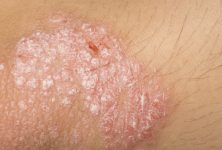
At the American Academy of Dermatology Virtual Meeting Experience 2021 (AAD VMX 2021), held in April 2021, Dr. Caroline Zhu, from the University of Texas Health Science Center at San Antonio, Texas, United States, presented this paper.
Botryomycosis, also known as granular bacteriosis or bacterial pseudomycosis, is a chronic granulomatous bacterial infection, often presents with papules or nodules draining yellow-white granules measuring (1-3mm.).The most common pathogen involved is Staphylococcus aureus. Pseudomonas is the next most common cause.
Risk factors include low T-cell counts, alcoholic liver disease, diabetes, HIV, cystic fibrosis, hyper-IgE syndrome, and chronic steroid use. In the majority of the patients, botryomycosis presents as a cutaneous disease, but visceral involvement may occur via hematogenous dissemination or contiguous spread. Visceral botryomycosis has been found to occur most frequently in the lungs, but it has also manifested in other organs, including the liver, spleen, kidney, and brain.
The study
This study evaluated a 41-year-old male with a history of HIV/AIDS, cytomegalovirus (CMV) retinitis and Pneumocystis pneumonia (PCP). Dermatology was consulted for a 1-month history of a lesion on the right wrist, which the patient attributed to an exuberant mosquito bite reaction. Notably, the patient was nonadherent to antiretroviral therapy, CD4 count <40. Past medical history included esophageal candidiasis, syphilis, alcohol use disorder, and a recently diagnosed high-grade anal intraepithelial neoplasm. Patient reported a recent 15-pound weight loss with intermittent fevers and diarrhea. Current medications include trimethoprim-sulfamethoxazole (TMP/SMX, for PCP prophylaxis), dolutegravir, emtricitabine and tenofovir alafenamide, all of which he was medically nonadherent to.
Punch biopsy was obtained for H&E and culture. Histopathologic examination showed suppurative granulomatous inflammation with basophilic granules centrally. The Splendore-Hoeppli phenomenon is exhibited at the periphery of the granules. Tissue culture speciated Staphylococcus aureus, and the patient noted improvement in the lesion after restarting TMP/SMX in the hospital for PCP pneumonia. Blood cultures were negative.
Re-initiation of anti-retroviral therapy was deferred given concern for Immune Reconstitution Inflammatory Syndrome in the setting of CMV retinitis. The decision was made to continue TMP/SMX for at least 21 days given PCP pneumonia, and the patient was requested to continue TMP/SMX until dermatology follow-up and reevaluation.
This case contributes to the developing literature regarding this relatively uncommon disease. Long-term antibiotic therapy is required, although there is no definitive guideline established as to duration of therapy. AIDS-associated cases may be resistant to multiple courses of antibiotics.
Surgical intervention may be considered in patients who have failed long-term/multiple courses of antibiotics and providers should be aware of this granulomatous infection as visceral involvement can present with a variety of manifestations.
- FECHA: 13/03/2024







